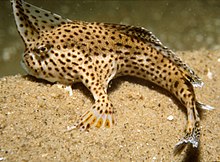Spotted handfish
| Spotted handfish | |
|---|---|

| |
| Scientific classification | |
| Domain: | Eukaryota |
| Kingdom: | Animalia |
| Phylum: | Chordata |
| Class: | Actinopterygii |
| Order: | Lophiiformes |
| Family: | Brachionichthyidae |
| Genus: | Brachionichthys |
| Species: | B. hirsutus
|
| Binomial name | |
| Brachionichthys hirsutus (
Lacépède , 1804) | |
| Synonyms[2] | |
| |

The spotted handfish (Brachionichthys hirsutus) is a
The spotted handfish is an unusual fish, in that it has highly adapted
Taxonomy
The spotted handfish was first formally
Etymology
The spotted handfish has the genus name Brachionichthys, which is a combination of brachium, meaning "arm", an allusion not explained by Bleeker, but it probably refers to the arm-like
Description
The spotted handfish is a rare species in the handfish family, Brachionichthyidae.[7]
The handfishes are a unique, Australian family of anglerfish, the most speciose of the few marine fish families endemic to Australia. Handfish are unusual, small (up to 120 millimetres (4.7 in) in length), slow-moving, fishes that prefer to 'walk' rather than swim. Their pectoral fins are leg-like with extremities resemblant of a sort-of hand (hence their common name). The females are believed to reach sexual maturity after two to three years at lengths of 75 millimetres (3.0 in) to 80 millimetres (3.1 in).[8][2]
Habitat
The spotted handfish is a
It chooses habitats based on the microhabitat features. It tends to prefer complex habitats with features such as depressions and ripple formations filled with shells to avoid predators.[1]
Reproduction

The species spawns sometime during September and October. Females lay a number of eggs varying from 80 to 250 eggs on a variety of vertical objects, including
B. hirsutus will select it's desired habitat when breeding season occurs. Due to the low movement range of the B. hirsutus from its chosen habitat, encountering other B. hirsutus becomes rare and lessens the probability of mating. This leads to potential risks of alleles effects on the populations due to low reproduction. Some B. hirsutus are also forced to increase effort in finding a mate due to the low movement range.[11]
Diet
Little is known regarding their diet, but they have been known to prey on small

Conservation
In 1996, the spotted handfish was the first marine fish to be listed as
The most urgent matter concerning the survival of the species is to address the threat posed by the presence of an introduced species of seastar, the
References
- ^ . Retrieved 17 March 2024.
- ^ a b Froese, Rainer; Pauly, Daniel (eds.) (2024). "Brachionichthys hirsutus" in FishBase. February 2024 version.
- ^ Eschmeyer, William N.; Fricke, Ron & van der Laan, Richard (eds.). "Species in the genus Brachionichthys". Catalog of Fishes. California Academy of Sciences. Retrieved 17 March 2024.
- ^ Eschmeyer, William N.; Fricke, Ron & van der Laan, Richard (eds.). "Genera in the family Brachionichthyidae". Catalog of Fishes. California Academy of Sciences. Retrieved 17 March 2024.
- OL 25909650M.
- ^ Christopher Scharpf (14 November 2022). "Order LOPHIIFORMES (part 1): Families LOPHIIDAE, ANTENNARIIDAE, TETRABRACHIIDAE, LOPHICHTHYIDAE, BRACHIONICHTHYIDAE, CHAUNACIDAE and OGCOCEPHALIDAE". The ETYFish Project Fish Name Etymology Database. Christopher Scharpf. Retrieved 17 March 2024.
- ^ "Brachionichthys hirsutus". Integrated Taxonomic Information System. Retrieved 18 April 2006.
- ^ a b c "Family Brachionichthyidae". Fishes of Australia. Museums Victoria. Retrieved 29 December 2021.
 Attribution 3.0 Australia (CC BY 3.0 AU) licence.
Attribution 3.0 Australia (CC BY 3.0 AU) licence.
- ISBN 0-643-06165-7.
- S2CID 39626211.
- PMID 30102710.
- ^ Shiffman, David (July 2020). "Smooth Handfish Extinction Marks a Sad Milestone". Scientific American. 323 (1): 14.
- Species Profile and Threats Database. SPRAT Profile. Department of Agriculture, Water and the Environment (Australia). Retrieved 30 December 2021.licence.
 Attribution 4.0 International (CC BY 4.0)
Attribution 4.0 International (CC BY 4.0) - ^ "Brachionichtys-hirsutus". Fishbase.
- ^ Anderson, Ian (26 February 2019). "Stowaway drives fish to brink of extinction". New Scientist. Retrieved 20 February 2021.
- ^ "Asterias amurensis". Global invasive species database. Invasive Species Specialist Group (ISSG). 10 March 2010. Retrieved 20 February 2021.
- ^ a b MacDonald, Lucy (20 February 2021). "Volunteers hope efforts to remove invasive northern Pacific seastar will make a difference". ABC News. Australian Broadcasting Corporation. Retrieved 20 February 2021.
General source
- Wong, Lincoln S. C.; Lynch, Tim P.; Barrett, Neville S.; Wright, Jeffrey T.; Green, Mark A.; Flynn, David J. H. (13 August 2018). Yue, Bi-Song (ed.). "Local densities and habitat preference of the critically endangered spotted handfish (Brachionichthys hirsutus): Large scale field trial of GPS parameterised underwater visual census and diver attached camera". PLOS ONE. 13 (8). Public Library of Science (PLoS): e0201518. PMID 30102710.
External links
- Froese, Rainer; Pauly, Daniel (eds.) (2021). "Brachionichthys hirsutus" in FishBase. February 2021 version.
- Fish that Walks on YouTube(1999)

